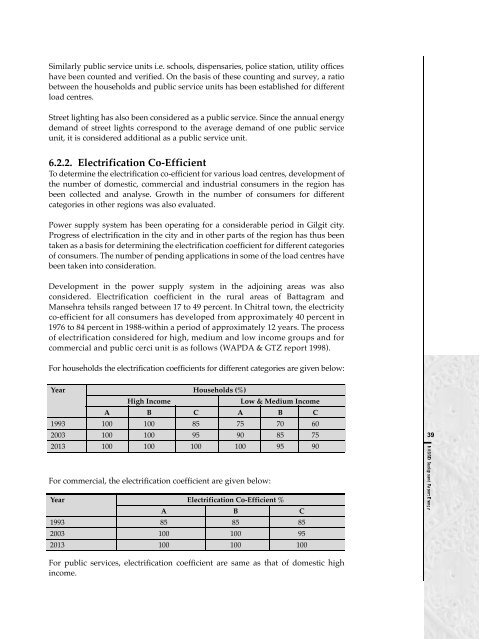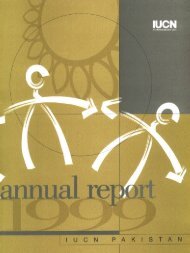Energy - IUCN
Energy - IUCN
Energy - IUCN
You also want an ePaper? Increase the reach of your titles
YUMPU automatically turns print PDFs into web optimized ePapers that Google loves.
Similarly public service units i.e. schools, dispensaries, police station, utility offices<br />
have been counted and verified. On the basis of these counting and survey, a ratio<br />
between the households and public service units has been established for different<br />
load centres.<br />
Street lighting has also been considered as a public service. Since the annual energy<br />
demand of street lights correspond to the average demand of one public service<br />
unit, it is considered additional as a public service unit.<br />
6.2.2. Electrification Co-Efficient<br />
To determine the electrification co-efficient for various load centres, development of<br />
the number of domestic, commercial and industrial consumers in the region has<br />
been collected and analyse. Growth in the number of consumers for different<br />
categories in other regions was also evaluated.<br />
Power supply system has been operating for a considerable period in Gilgit city.<br />
Progress of electrification in the city and in other parts of the region has thus been<br />
taken as a basis for determining the electrification coefficient for different categories<br />
of consumers. The number of pending applications in some of the load centres have<br />
been taken into consideration.<br />
Development in the power supply system in the adjoining areas was also<br />
c o n s i d e red. Electrification coefficient in the rural areas of Battagram and<br />
Mansehra tehsils ranged between 17 to 49 percent. In Chitral town, the electricity<br />
c o - e fficient for all consumers has developed from approximately 40 percent in<br />
1976 to 84 percent in 1988-within a period of approximately 12 years. The pro c e s s<br />
of electrification considered for high, medium and low income groups and for<br />
c o m m e rcial and public cerci unit is as follows (WA P D A & GTZ report 1998).<br />
For households the electrification coefficients for diff e rent categories are given below:<br />
Year Households (%)<br />
High Income<br />
Low & Medium Income<br />
A B C A B C<br />
1993 100 100 85 75 70 60<br />
2003 100 100 95 90 85 75<br />
2013 100 100 100 100 95 90<br />
39<br />
For commercial, the electrification coefficient are given below:<br />
Year Electrification Co-Efficient %<br />
A B C<br />
1993 85 85 85<br />
2003 100 100 95<br />
2013 100 100 100<br />
For public services, electrification coefficient are same as that of domestic high<br />
income.
















